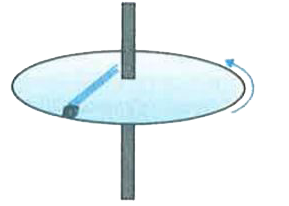A small trolley of mass 2.0kg resting on a horizontal turn table is connected by a light spring to the centre of the table. When the turn table is set into rotation a speed of 600rpm, the length of stretched spring is 50cm. If the original length of the spring is 42cm, find the force constant of the spring.
Here, mass of trolley, m=2.0kg,
Frequency of rotation, v=60060=10rps
Extension produced in string,
x=50−42=8cm=8×10−2m
When the turn table is set into rotation, the tension (restoring force), in the spring is equal to the centrifugal force. Then length of stretched spring, r=50cm=0.50m.
∴F=kx=mr(2πv)2=4π2mrv2
or k=4π2mrv2x
=4×(22/7)2×2.0×0.50×(10)28×10−2
=49387.7Nm−1
Topper's Solved these Questions
- OSCILLATIONS AND WAVESBOOK - PRADEEPCHAPTER - OSCILLATIONS AND WAVESEXERCISE - conceptual problems
84 Videos
- OSCILLATIONS AND WAVESBOOK - PRADEEPCHAPTER - OSCILLATIONS AND WAVESEXERCISE - Very Short Answer Questions
99 Videos
- OSCILLATIONS AND WAVESBOOK - PRADEEPCHAPTER - OSCILLATIONS AND WAVESEXERCISE - CURIOSITY QUESTION
2 Videos
- MATHEMATICAL TOOLSBOOK - PRADEEPCHAPTER - MATHEMATICAL TOOLSEXERCISE - Fill in the blanks
5 Videos
- PHYSICAL WORLD AND MEASUREMENTBOOK - PRADEEPCHAPTER - PHYSICAL WORLD AND MEASUREMENTEXERCISE - Competiton Focus Jee Medical Entrance
18 Videos
Similar Questions
A small trolley of mass 2.0kg resting on a horizontal turn table is connected by a light spring to the centre of the table. When the turn table is set into rotation at a speed of 360 rpm,, the length of the stretched spring is 43cm. If the original length of the spring is 36cm, determing the force constant of the spring.
View SolutionA small trolley of mass 2.0 kg resting on a horizontal turn table is connected by a light spring to the centre of the table. When the turn table is set into rotation at a speed of 300 rpm, the length of the stretched spring is 40 cm. If the original length of the spring is 35 cm, determine the force constant of the spring.
View Solution
Knowledge Check
Two blocks of mass m1 and m2, resting on a frictionless table, are connected by a stretched spring and then released -
Aratio of speed of blocks is m2/m1Bratio of kinetic energy of blocks is m2/m1Ccentre of mass will move towards heavier blockDmechanical energy will remain conserve in this processA block of 200 g mass is dropped from a height of 2 m on to a spring and compress the spring to a distance of 50 cm. The force constant of the spring is
A20Nm−1B40Nm−1C30Nm−1D60Nm−1A body of mass m is tied to one end of a spring and whirled round in a horizontal circle with a constant angular velocity .The elongation is 1 cm . If the angular velocity is doubled , the elongation in the spring is 5 cm. what is the original length of the spring ?
A13 cmB14 cmC15 cmD16 cm
A small block of mass 1 kg is placed on a horizontal table, connected by a weightless spring to the central rod of the table as shown in the adjoining figure.
the table is set to rotate at a speed of 200 rpm which causes spring to stretch by 5 cm. If the original length of the spring is 30 cm, determine its force constant.

View SolutionA particle of mass m is moving with a constant speed v in a circular path in a smooth horizontal plate (plan of the paper ) by a spring force as shown in figure If the natural length of the spring is l0 and stiffeness of the spring is k find the elongation of the spring

View SolutionTwo blocks of masses m and m' are connected by a light spring on a horizontal frictionless table . The spring is compressed and then released . Find the ratio of acceleration of masses .
View SolutionWhen a 20 g mass hangs attached to one end of a light spring of length 10 cm, the spring stretches by 2 cm. The mass is pulled down until the total length of the spring is 14 cm. The elastic energy, (in Joule) stored in the spring is :
View SolutionTwo identical blocks A and B , each of mass m resting on smooth floor are connected by a light spring of natural length L and spring constant k, with the spring at its natural length. A third identical block C (mass m) moving with a speed v along the line joining A and B collides with A. The maximum compression in the spring is
View Solution
